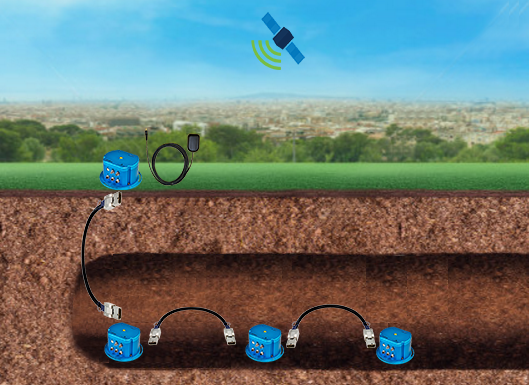

TRITON Seismograph is an integrated data acquisition system plus sensor which was conceived for applications where a combined and space-saving solution are required. Very low seismic noise levels are achieved, thanks to the sensor being shielded inside the enclosure and to the short wiring.
TRITON Seismograph is available with geophones or with short/broad band sensor.
The TRITON seismograph can be equipped with extra inputs for 3 or 6 24-bit channels. In this configuration, in addition to the internal sensor, the instrument can be externally connected to two other high dynamic sensors.
The instrument is equipped with high-resolution delta-sigma 24bit ADCs, all the channels are synchronized and the sample rate is adjustable up to 1000 sps per channel. The internal memory (up to 1TByte) has two independent recording zones: the ring-buffer zone which is dedicated to continuous sampling, and the triggering zone which is used for event sampling.
You can control Triton Seismograph locally via network connection (LAN or WiFi), and remotely using the optionally integrated 4G modem.
The instrument can be used as a “stand-alone” unit to record seismic events in the field or it can be used in a MASTER-SLAVE based monitoring network where multiple instruments are connected to each other; the MASTER device manages the interconnection with the other SLAVE units, collecting data coming from them and managing connection with the remote server. Furthermore, MASTER and SLAVE units can perform periodic analysis of the ambient noise and post-seismic vibrations in order to evaluate structural damage caused by an earthquake, in real-time.
Thanks to SeedLink protocol the Triton is compatible with most popular seismic analysis software (Seiscomp3, Antelope, Earthworm).
TRITON’s power supply ranges from 9 to 28V, it can be connected to the electric power network using the included power supply adapter. TRITON is equipped with an internal battery (LiPo) which can guarantee an autonomy of about 33 hours in the case of a blackout. This feature is greatly appreciated by our customers because it is like having an integrate UPS, and it saves space and money; both the 4G modem and the external sensors’ power supply is backed up by the internal battery.
The anodized aluminum (INOX AISI316 option) enclosure is CNC milled, shockproof, vibration-resistant, weather-resistant and designed with a built-in mounting brackets for easy installation.
TRITON is designed to suit various applications and provide a solution to the users needs in the field.

Stand Alone Geophysical or Structural Surveys
In this operational mode, TRITON acquires data as a simple recorder, storing it on
its memory or making it available on a miniSeed stream. The user will then decide if
they want to interact with Triton in-site with a
mobile/tablet or remotely.

Daisy Chain
Daisy Chain connection is intended for all the applications where many devices are
installed in-line and where guaranteeing enough sky-view for GNSS is difficult and
there’s no local power supply.
Benefiting from the daisy chain connection, TRITON-MASTER, which guarantees GNSS coverage and power supply, will then synchronize and power-up all the installed instruments. Thanks to the pass-through connection, each device can pass synchronization and power supply to the next one.
You can have TRITON configured according to your needs
TRITON seismograph models are:
Models are available in Tri-axial, Bi-axial or uni-axial sensor configurations.
| Inputs | Differential |
| Channels | 3 low noise 24bit |
| Dynamic Range | >136dB@100Sps |
| Sampling Rate | 10,100,200,250,500,1000 Sps |
| Sampling Topology | Synchronous |
| Data Format | MiniSeed or Proprietary |
| Trigger | STA/LTA |
| Timing | Built-in GNSS receiver |
| Timestamp | Encapsulated in data |
| LAN | 10/100 ethernet port |
| WiFi | Optional built-in |
| Cellular Modem | Optional built-in |
| Power Supply | 9-28 Volt DC – power consumption < 2W |
| Back up Battery | Internal LiPo |
| System Autonomy w/o external supply | 33 hours |
| Configuration | Web Interface |
| Compatibility | Earthworm,Antelope,Geopsy,SeiscomP and SeisGram2K |
| Weight | 2Kg |
| IP protection | IP68 |
| Temperature Range | -40°C to +70°C |
* LiPo batteries can be discharged between -20°C to +70°C.
LiPo batteries can be charged between 0°C to +45C°.
If temperature exceeds these limits, the charging process is suspended.

